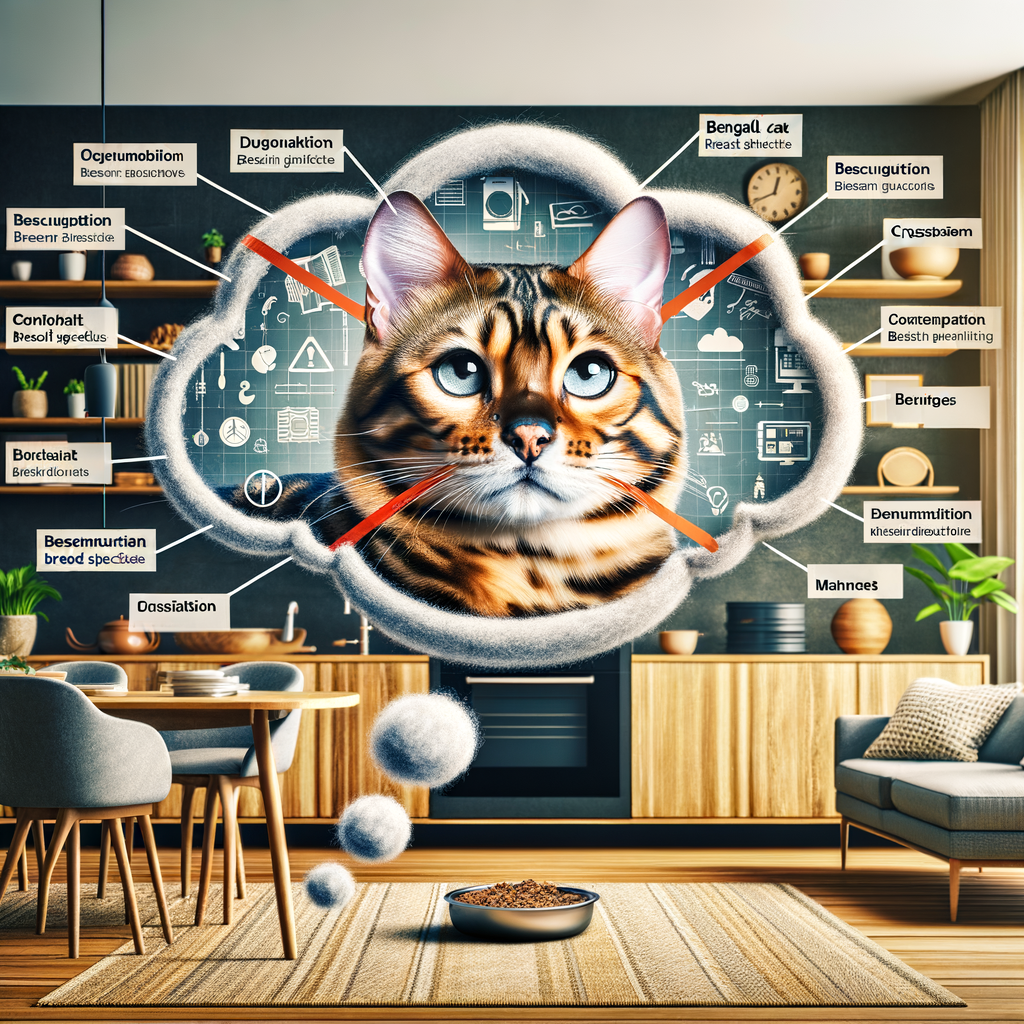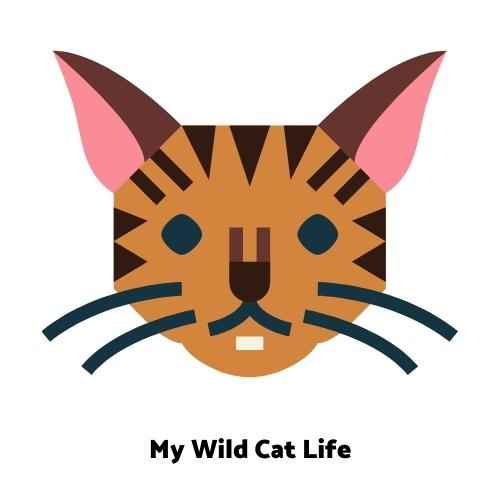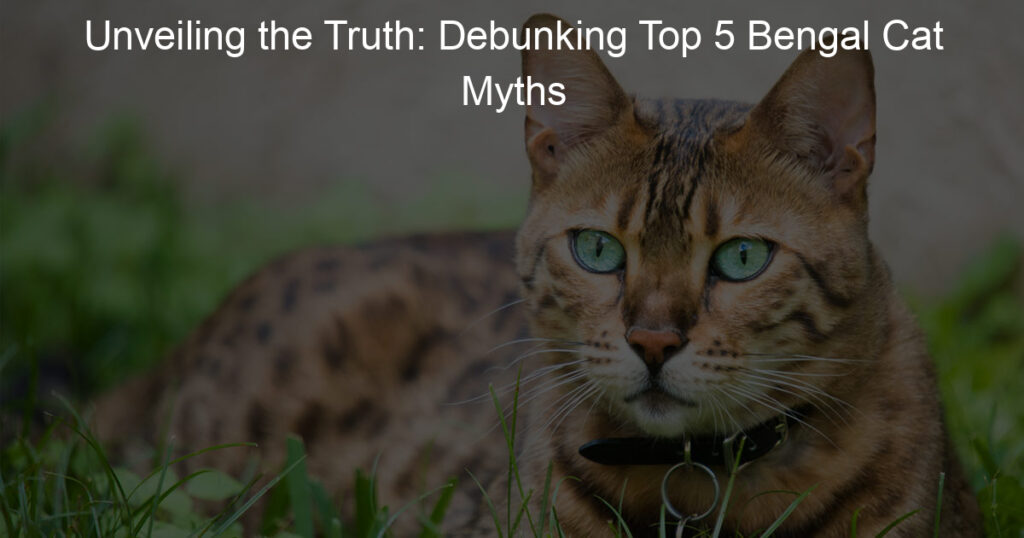
Introduction: Understanding Bengal Cats
When it comes to the world of felines, Bengal cats are a breed that stands out. With their striking appearance and unique personality, they are a fascinating breed to explore. In this article, we will delve into the world of Bengal cats, providing an overview of the breed and debunking some common misconceptions.
The Bengal cat is a domesticated cat breed created from hybrids of domestic cats and the Asian leopard cat. The breed name comes from the leopard cat’s taxonomic name, Bengalensis. They have a wild appearance with large spots, rosettes, and a light/white belly, and are covered with a soft and luxurious coat.
Bengal cats are known for their playful, active, and intelligent nature. They are highly energetic and require plenty of stimulation. They love to climb and will appreciate tall cat trees and shelves. Bengals are also known for their love of water, a trait not commonly seen in cats.
| Characteristic | Description |
|---|---|
| Appearance | Wild, with large spots and rosettes, light/white belly |
| Coat | Soft and luxurious |
| Personality | Playful, active, intelligent |
| Unique Trait | Loves water |
Despite their popularity, there are several misconceptions about Bengal cats. One common myth is that they are wild and dangerous because of their ancestry. However, this is not the case. While they are energetic and playful, Bengal cats are domesticated and pose no more threat than any other cat breed.
Another misconception is that Bengal cats require a special diet due to their wild ancestry. This is also untrue. Bengal cats do well on a diet of high-quality commercial cat food, just like any other domestic cat.
Finally, some people believe that Bengal cats are hypoallergenic. While they do produce fewer allergens than some other breeds, no cat breed is completely hypoallergenic. People with severe allergies may still react to a Bengal cat.
Debunking Bengal Cat Myths
There are many misconceptions about Bengal cats that have been circulating for years. In this section, we will debunk some of these myths and shed light on the true nature of these beautiful creatures.
Myth 1: Bengal Cats are Wild and Aggressive
One common myth is that Bengal cats are wild and aggressive. This is not entirely true. While Bengal cats do have a wild ancestry, they are domesticated pets that can be just as loving and gentle as any other breed.
- Truth about Bengal Cat Behavior: Bengal cats are known for their playful and active nature. They love to explore their surroundings and can be quite energetic. However, this does not mean they are aggressive. With proper socialization and training, Bengal cats can be very well-behaved and friendly.
- Understanding Bengal Cat Characteristics: Bengal cats are intelligent and curious creatures. They are known for their striking coat patterns, which resemble those of their wild ancestors. However, their behavior is more similar to that of domestic cats. They are social animals that enjoy the company of their human families.
It’s important to remember that every cat is unique and their behavior can vary depending on various factors such as their upbringing, environment, and individual personality. Therefore, labeling all Bengal cats as wild and aggressive is not accurate or fair.
Myth 2: Bengal Cats Require Special Diets
One of the most common misconceptions about Bengal cats is that they require a unique, specialized diet. Let’s debunk this myth and explore the true dietary needs of Bengal cats.
-
- Facts about Bengal Cat Dietary Needs
Contrary to popular belief, Bengal cats do not require a specialized diet. Like any other domestic cat, Bengals thrive on a balanced diet of high-quality cat food. This should ideally consist of both wet and dry food, providing a mix of protein, fats, and carbohydrates. Bengals are known for their high energy levels, so they may require slightly more food than less active breeds. However, this does not mean they need a special diet.
| Key Nutrients | Percentage in Diet |
|---|---|
| Protein | 40% |
| Fats | 30% |
| Carbohydrates | 30% |
Remember, it’s always best to consult with your vet to determine the right amount and type of food for your Bengal cat, taking into account their age, weight, and activity level.
-
- Case Study: Bengal Cat Diet
Consider the case of Bella, a Bengal cat who was mistakenly fed a diet designed for wild cats. Her owner believed the myth that Bengals require a special diet and started feeding her raw meat exclusively. Bella developed nutritional deficiencies and had to be treated by a vet. Once Bella switched to a balanced diet of high-quality cat food, her health improved dramatically.
In conclusion, while Bengal cats may have a wild appearance, their dietary needs are not different from other domestic cats. Feeding your Bengal a balanced, high-quality diet will ensure they stay healthy and happy.
Myth 3: Bengal Cats are not Affectionate
Many people believe that Bengal cats are not affectionate. This myth is far from the truth. Let’s delve deeper into understanding Bengal cat behavior and explore examples of affectionate Bengal cats to debunk this myth.
- Understanding Bengal Cat Behavior
Bengal cats are known for their playful and energetic nature. They are highly interactive and enjoy the company of their human companions. While they may not be as cuddly as some other breeds, their form of affection is often expressed differently.
For instance, Bengal cats may show their love by following their owners around the house, engaging in play, or even helping with household tasks. They are also known to communicate their affection through purring and rubbing against their owner’s legs. These behaviors are all signs of a Bengal cat’s affection and love.
- Examples of Affectionate Bengal Cats
Let’s look at some examples of affectionate Bengal cats. Take Missy, for instance, a Bengal cat owned by a family in California. Missy is known to greet her family members at the door when they come home, often rubbing against their legs and purring loudly. She also enjoys playing fetch with small toys and will often bring them to her owners to initiate playtime. This is her unique way of showing affection.
Then there’s Max, a Bengal cat from New York. Max loves to follow his owner around the house, always wanting to be in the same room. He also enjoys sitting next to his owner on the couch, often placing a paw on their lap. These behaviors are clear indications of Max’s affectionate nature.
In conclusion, Bengal cats are indeed affectionate in their own unique ways. They may not show affection in the same way as other cat breeds, but they certainly have their own special ways of expressing their love and attachment to their human companions.
Remember, every Bengal cat is unique and will express affection in its own way. The key is to understand and appreciate their unique behaviors and expressions of love.
Myth 4: Bengal Cats are High Maintenance
Many people believe that Bengal cats are high maintenance. This is a common misconception. Let’s debunk this myth and shed some light on the truth about Bengal cat care and maintenance.
-
- Truth about Bengal Cat Care
Bengal cats are known for their striking appearance and active lifestyle. They are not any more high maintenance than other cat breeds. In fact, they are quite easy to care for. They need regular feeding, a clean litter box, and plenty of playtime, just like any other cat. They do have a strong desire for interaction and stimulation, which means they enjoy playtime and activities. But this doesn’t make them high maintenance, it just makes them fun and engaging pets!
-
- Practical Tips for Bengal Cat Maintenance
Caring for a Bengal cat doesn’t have to be a daunting task. Here are some practical tips:
-
- Regular Feeding: Feed your Bengal cat a balanced diet. This can be a mix of dry and wet cat food. Make sure to provide fresh water at all times.
- Clean Litter Box: Keep the litter box clean. Bengal cats are very clean animals and a dirty litter box can cause them stress.
- Playtime: Engage your Bengal cat in play activities. They love to play and it’s a great way to keep them active and happy.
- Regular Vet Check-ups: Regular vet check-ups are important to ensure your Bengal cat is healthy. This is a standard part of pet care for any breed.
In conclusion, Bengal cats are not high maintenance. They are active, playful, and require the same basic care as any other cat breed. So, if you’re considering bringing a Bengal cat into your home, don’t let the myth of high maintenance deter you. They are wonderful, loving pets that can bring a lot of joy to your life.
Myth 5: Bengal Cats are not Good with Children or Other Pets
One common misconception about Bengal cats is that they do not get along with children or other pets. This myth, like many others, is not entirely accurate. Let’s delve deeper into the social behavior of Bengal cats and look at some examples of these cats in family settings.
- Understanding Bengal Cat Social Behavior
Bengal cats are known for their energetic and playful nature. They are highly interactive and enjoy being part of family activities. They are intelligent and curious, often seeking out companionship and stimulation.
While it’s true that Bengal cats have a strong hunting instinct, this doesn’t mean they can’t get along with other pets. They can coexist peacefully with other animals, provided they are properly socialized from a young age. It’s important to introduce them to other pets gradually and under controlled conditions to ensure a positive relationship.
As for children, Bengal cats can be excellent companions. They are sturdy and can handle the energetic play of children. However, like any pet, they should be treated with respect and children should be taught how to interact with them appropriately.
- Examples of Bengal Cats in Family Settings
Many families have successfully integrated Bengal cats into their homes. For instance, the Johnson family from Ohio has a Bengal cat named Tigger who gets along wonderfully with their two young children and their Golden Retriever. Tigger is often found playing with the kids or snuggling up with the dog.
Similarly, the Smith family from California has two Bengal cats, Simba and Nala, who are best friends with their pet rabbit. The cats and the rabbit often play together, proving that Bengals can indeed get along with other pets.
These are just a couple of examples, but there are countless stories of Bengal cats living harmoniously with children and other pets. It all comes down to proper socialization, understanding their behavior, and providing a loving and respectful environment.
In conclusion, the myth that Bengal cats are not good with children or other pets is simply not true. With the right approach and understanding, a Bengal cat can be a wonderful addition to any family.
Conclusion: The Truth about Bengal Cats
As we draw to a close, let’s take a moment to reflect on the fascinating world of Bengal cats. These unique felines are more than just their striking appearance. They are a blend of wild beauty and domestic charm, full of surprises and debunked myths.
-
- Summary of Bengal Cat Facts
Bengal cats are a hybrid breed, a mix of an Asian Leopard Cat and a domestic cat. They are known for their distinctive coat that resembles that of their wild ancestors. They are active, playful, and intelligent creatures, often displaying a high level of curiosity and a love for water, which is quite unusual for cats.
Despite their wild appearance, Bengal cats make excellent pets. They are affectionate, sociable, and get along well with other pets and children. They are also known for their vocal nature, often communicating their needs and desires through a variety of sounds.
However, they require a lot of stimulation and exercise to keep them happy and healthy. They are not a breed for those looking for a low-maintenance pet. They need a diet rich in protein and regular vet check-ups to ensure they are in the best of health.
-
- Key Takeaways: Debunking Bengal Cat Myths
Throughout this article, we have debunked several myths about Bengal cats. They are not wild, dangerous, or overly aggressive as some might believe. They are not hypoallergenic, despite some claims, and they do shed, although less than many other breeds.
They are not a breed that can be left alone for long periods, as they crave interaction and stimulation. They are not suited to a diet of just dry food, requiring a balanced diet with a high protein content.
Understanding these facts and debunking the myths helps potential owners make informed decisions about whether a Bengal cat is the right pet for them. It’s essential to remember that every Bengal cat is unique and may not fit the ‘typical’ breed characteristics.
In conclusion, Bengal cats are a captivating blend of the wild and the domestic. They are a breed full of surprises, debunked myths, and unique traits that make them a joy to have as a pet. However, they require a committed owner who can meet their needs and provide them with a loving, stimulating environment.
Additional Information on Bengal Cats
As a potential Bengal cat owner, it’s essential to understand the unique health needs of this breed. In this section, we’ll delve into common health issues and provide tips for maintaining Bengal cat health.
Bengal Cat Health Information
Bengal cats are generally healthy, but like all breeds, they’re prone to certain health conditions. Not all Bengals will get any or all of these diseases, but it’s important to be aware of them if you’re considering this breed.
-
- Common Health Issues in Bengal Cats
Bengal cats are susceptible to certain genetic health problems, including:
-
-
- Progressive Retinal Atrophy (PRA): This is a degenerative eye disorder that eventually causes blindness. The good news is that PRA is detectable years before the cat shows any signs of blindness.
- Pyruvate Kinase Deficiency (PK Deficiency): This is a genetic disease that can cause anemia. Fortunately, a genetic test can determine whether cats carry the gene for PK deficiency.
- Hypertrophic Cardiomyopathy (HCM): This is the most common form of heart disease in cats. It causes enlargement (hypertrophy) of the heart muscle.
- Tips for Maintaining Bengal Cat Health
-
Here are some tips to help keep your Bengal cat healthy:
-
- Regular Vet Check-ups: Regular veterinary care is crucial to catch any potential health issues early.
- Proper Nutrition: A balanced diet is key to overall health. Ensure your Bengal cat gets the right nutrients it needs.
- Exercise: Bengal cats are active and need regular exercise to maintain optimal health.
- Genetic Testing: Consider genetic testing to identify potential health risks.
Remember, the best way to ensure your Bengal cat’s health is through preventative care and regular check-ups. Always consult with a vet for your cat’s specific health needs.
Adopting a Bengal Cat: Things to Consider
Adopting a Bengal cat can be a rewarding experience, but it’s important to understand their unique needs and know where to find resources for adoption. Here are some key points to consider:
-
- Understanding Bengal Cat Needs
Bengal cats are known for their active and playful nature. They require plenty of mental and physical stimulation to stay happy and healthy. This means they need toys, scratching posts, and plenty of interaction with their human family. Bengals also have a unique coat that requires regular grooming to keep it shiny and healthy. They are also known for their love of water, so don’t be surprised if your Bengal cat wants to join you in the shower!
-
- Resources for Bengal Cat Adoption
There are many resources available for those looking to adopt a Bengal cat. Local animal shelters and rescue groups often have Bengal cats or Bengal mixes available for adoption. There are also breed-specific rescue organizations that focus solely on Bengal cats. When adopting, it’s important to ask about the cat’s health history and behavior. Remember, adoption is a lifelong commitment, so make sure you’re ready to provide a loving home for your new Bengal cat.
In conclusion, adopting a Bengal cat requires understanding their unique needs and knowing where to find resources for adoption. With the right preparation and commitment, you can provide a loving home for a Bengal cat and enjoy their playful and affectionate nature.














